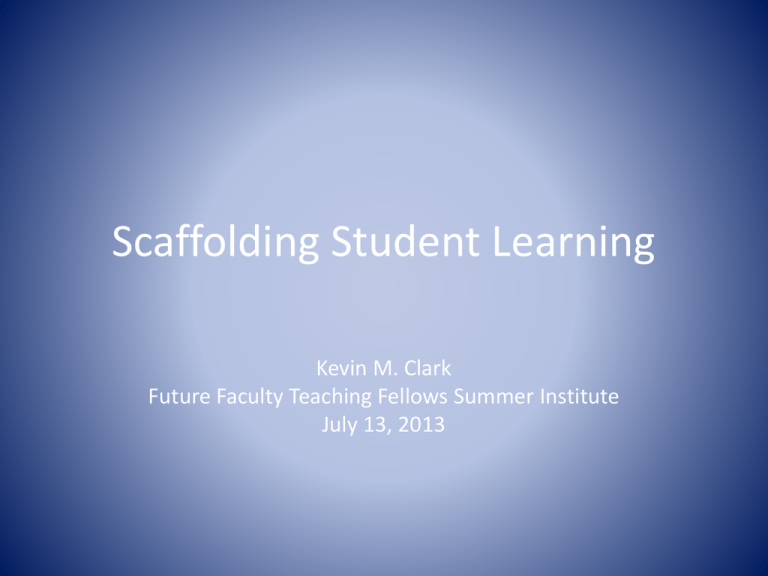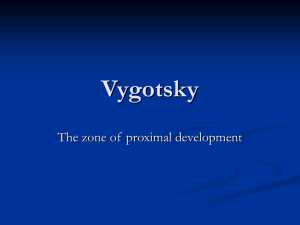Motivating students to learn
advertisement

Scaffolding Student Learning Kevin M. Clark Future Faculty Teaching Fellows Summer Institute July 13, 2013 Opening Question • So what is teaching anyway??? Common Teaching Practices • Lecture – should I tell students something? • Discussion – should I try to get students to talk about something? • Activity – should I have students do something? Courses I Teach • • • • • • • • General Psychology (PSY P103) Lifespan Development Psych. (PSY P216) Statistical Techniques (PSY K300) The Psychology of Learning (PSY P325) Cognitive Psychology (PSY P335) Behavioral Neuroscience (PSY P326) History & Systems of Psychology (PSY P459) Special Topics (PSY P390): – The Psychology of Creativity – Political Psychology – Motivation to Learn Planning for Class • Frame #1: How can I “fill” class time today? • Frame #2: What is the most important content I should “cover” today? • Frame #3: How can I incorporate new technology and teaching “fads” into class today? Planning for Class • Frame #4: In what activities should students engage today? • Frame #5: What do I want students to learn today? • Frame #6: How can I best assist student learning today? Teaching as Scaffolding Student Learning • Scaffolding is providing students with needed assistance and support so as to maximize their learning. • It is aimed at expanding capabilities and developing mastery. • Assistance is reduced as learning becomes more self-regulated and support is no longer needed. Vygotsky (1978): Zone of Proximal Development (ZPD) http://www.innovativelearning.com/educational_psychology/development/zone-of-proximal-development.html Implications of Vygotsky’s ZPD • Teach (scaffold or assist performance) in the ZPD. • Distinguish current performance vs. potential for learning. What should we scaffold? • Concepts (literacy) – Understanding – Application • Thinking – Critical thinking – Metacognition/Reflexivity • Motivation – Expectancy (self-efficacy) – Value Tharp & Gallimore (1988): Means of Assisting Performance • Modeling • Contingency management (reinforcement/punishment) • Feedback • Instruction • Questioning • Cognitive structuring – Conceptual understanding – Task structuring Lave & Wenger (1991): Legitimate Peripheral Participation (LPP) From: University of South Alabama, Online Learning Laboratory, Retrieved 7/13/11 from http://www.innovativelearning.com/educational_psychology/development/zone-of-proximal-development.html Implications of Lave & Wenger’s LPP • Understand learning as intertwined with issues of belonging and identity. • Connect (and help students see connections between) class activities and meaningful practices. • Recognize class practices and student goals may differ from those teachers intend/desire. – Example (see Brophy, 2010): • Learning Goals • Performance Goals • Work Avoidance Goals So how can we scaffold students preparation for class? • Class Preparation Assignments • Daily/Weekly Quizzes • Reflection Papers/“Talking Points” • Review (e.g., stats “math review”) Scaffolding During Lectures • Emphasize most important & challenging ideas • Use “interactive lectures” (teacher-led conversation) • Provide cognitive structuring • Model concepts as tools for thinking • Demonstrate applications and relevance • Connect to prior learning • Embed discussions, activities, & concept checks Scaffolding During Discussions • Create a community of learners (e.g., the “name quiz”) • Model critical thinking/reading and respectful dialogue • Use discussion as context for scaffolding understanding/literacy • Push students toward deeper thinking (e.g., probing follow-ups, “devil’s advocate”) • Use “reciprocal teaching” (summarizing, clarifying, questioning, predicting) • Provide cognitive structuring (e.g., frameworks for integrating emerging ideas) • Mix in personal reflections, “think-pair-share”, or small-group discussions • End with “final thoughts” Scaffolding with Activities/Assignments • Move from “hands on” to “minds on” (Brophy, 2010). – – – – – – – – Expert panels/debates JIGSAW technique: expert groups learning groups Film analyses/product reviews Newsletters/workshops (for a specific audience) Dialogues (among key figures/from different perspectives) Poster sessions/student presentations Case analysis/Personal intellectual history papers “Final Essay” assignment References • Brophy, J. (2010). Motivating students to learn (3rd ed.). New York: Routledge. • Lave, J., & Wenger, E. (1991). Situated learning: Legitimate peripheral participation. New York: Cambridge University Press. • Tharp, R. G., & Gallimore, R. (1988). Rousing minds to life: Teaching, learning, and schooling in social context. New York: Cambridge University Press. • Vygotsky, L. S. (1978). Mind in society: The development of higher psychological processes (M. Cole, V. John-Steiner, S. Scribner, & E. Souberman, Eds. & Trans.) Cambridge, MA: Harvard University Press. Contact Info Kevin M. Clark Associate Professor of Psychology Indiana University Kokomo (765) 455-9342 kevclark@iuk.edu











